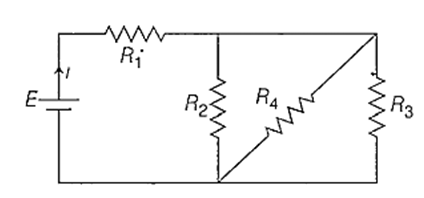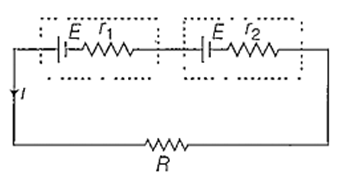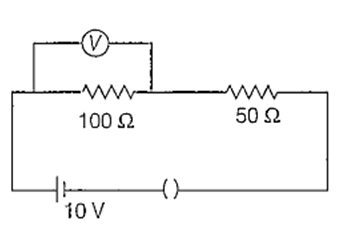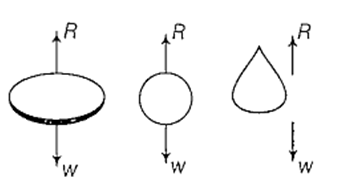 Multiple Choice Questions
Multiple Choice QuestionsIn the circuit grven E =6.0 volt, R1 = 100 Ω, R2 = R3 = 50 Ω, R4 = 75 Ω. The equivalent resistance of the circurt, in ohms, is

11.875
26.31
118.75
None of these
Two resistances are connected in two gaps of a metre bridge. The balance point is 20 cm from the zero end. A resistance of 15 ohms is connected in series with the smaller of the two. The null point shifts to 40 cm. The value of the smaller resistance in ohms is
3
6
9
12
If the potential difference across the internal resistancer is equal to the emf E of the battery, then

R = r1 + r2
R = r1 − r2
By using only two resistance coils-singly, in senes or in parallel one should be able to obtain resistances of 3, 4, 12 and 16 ohms. The separate resistances of the coil are
3 and 4
4 and 12
12 and 16
16 and 3
In the given circuit, the voltmeter records 5 volts. The resistance of the voltmeter in ohms is

200
100
10
50
B.
100
Let the resistance of voltmeter is G Ω
∴ Total resistance of the circuit
Voltage across 100 Ω resistance
Reading of voltmeter = 5 volts
∴ Voltage across 100 Ω = 5 volts
On solving G = 100 Ω
When a body falls in air, the resistance of air depends to a great extent on the shape of the body. 3 different shapes are given. Identify the combination of air resistances which truly represents the physical situation. (The cross-sectional areas are the same).

1. Disc 2. Ball 3. Cigar shaped
1 < 2 < 3
2 < 3 < 1
3 < 2 < 1
3 < 1 < 2
A battery of emf 10 V and internal resistance 3 Ω is connected to a resistor. The current in the circuit is 0.5 A. The terminal voltage of the battery when the circuit is closed is
10 V
0 V
1.5 V
8.5 V
The electron dirft speed is small and the charge of the electron is also small but still, we obtain large current in a conductor. This is due to
the conducting property of the conductor
the resistance of the conductor is small
the electron number density of the conductor is small
the electron number density of the conductor is enormous
